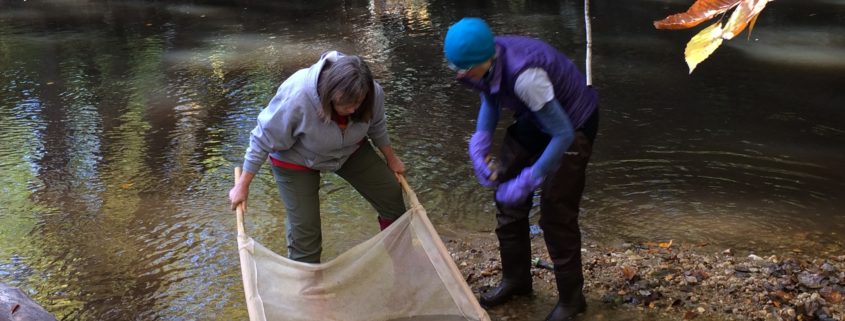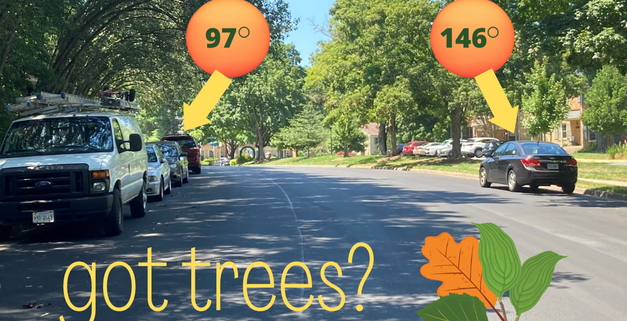
Recognizing Cathy Ledec for her support of County environmental initiatives. Photo courtesy of BOS newsletter.
In July 2022 the Fairfax County Board of Supervisors (BOS) distinguished FMN Cathy Ledec, former chair of the Fairfax County Tree Commission, with a proclamation for her years of service in progressing our County’s environmental initiatives. Notably, Cathy led the charge in developing the 2019 Tree Action Plan for Fairfax County which, through its robust inclusion of a diverse group of stakeholders, continues to serve as a model for how the county develops environmental initiatives.

Photo Rachel Habig-Meyers County Urban Forest Management Division
Cathy joined the Fairfax County Tree Commission in 2016 and an early draft of an update to the Tree Action Plan had been prepared. Starting in 2016 she worked to improve the draft and positively influenced the final version submitted by committee, which was approved towards the end of 2019. The Tree Action Plan is a document of the Fairfax County Tree Commission. Tree action plan.
Cathy was also a key contributor to the Community-wide Climate Action Plan (CECAP) developed in large part by citizen volunteers and then approved in 2021 by Fairfax County. In a New York Times article Jim McKay (Chairman, BOS) emphasized that the county’s climate action plan is unusual in part because it was produced by several dozen community members instead of county officials. In most cases, programs like these come from the top down.
One goal of the plan, approved in September 2021, is to educate county residents about environmentally friendly choices they can make. “If the community’s not on board, you’re not going to accomplish anything other than to write a beautiful plan and have it sit on the shelf and collect dust,” said McKay.
A group of more than 50 residents heard from experts, examined data, debated and voted on recommendations. The document identified 12 broad strategies in five areas: buildings and energy efficiency, energy supply, transportation, waste, and natural resources. The strategies were broken into 37 recommended actions and scores of narrower “activities.”
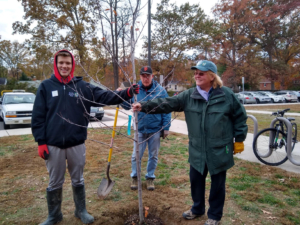
Planting for the future. Photo George Ledec
Dan Storck (Mt. Vernon District Supervisor) extolled Cathy’s past performance and service to Fairfax County in an official letter by writing, “Cathy served on the Fairfax County Tree Commission since 2016, and as Chair since January 2019, until she recently stepped down. As Chair, Cathy led the creation of the 2019 Fairfax County Tree Action Plan, which was subsequently approved by the Board of Supervisors, and led to the institution of the Community of Practice in 2020. During Cathy’s tenure, she led discussions and compiled research for the Commission to comment on a variety of County Board priorities, including solar projects and trees, the Joint County/Schools Environmental Task Force (JET) recommendations, land use decisions affecting trees, actions affecting trees in the Community Energy and Climate Action Plan’s (CECAP), among others. As noted by the current Chair of the Tree Commission, Cindy Speas, “Cathy’s work made the Tree Commission more relevant in a changing environmental world through the adoption of the Tree Action Plan and the Community of Practice”.”
The letter continued by noting, “Cathy has served on the Friends of Huntley Meadows Park since 2010 and as its elected President since 2012, where her leadership has contributed significantly to the long-term preservation of natural resources at Huntley Meadows and throughout Fairfax County. She volunteers with the Resource Management Division (RMD) of the County Park Authority (FCPA) assigned to Huntley Meadows, educating the public on the importance of being good environmental stewards and contributing to data collection supporting scientific research. Cathy has led countless cleanups, invasive species removals, bird counts, nature walks and organized volunteers for many other park activities. In 2020, Cathy received the Sally Ormsby Environmental Stewardship Award for 17 years of volunteer service at Huntley Meadows Park and for the Fairfax County Park Authority.” She even donated a bench to Huntley Meadows Park.

Cathy and George Ledec Bench at Huntley Meadows- photo Jerry Nissley
Mr. Storck commended Cathy and her service by saying, “Cathy is truly a protector of our natural world, from every bee to every tree. Her knowledge of trees, natural landscaping, climate and environmental issues, living shorelines and so much more is unmatched, as is her passion and enthusiasm”.
Cathy also serves our community via her multi-functional involvement in many citizen action groups such as, Friends of Huntley Meadows Park, Inc. (FOHMP), Board Member Emeritus; Fairfax County Park Authority, Resource Management Division, Huntley Meadows Park, 2003 to present; Invasive Management Area Program: Site Leader, Mount Eagle Park, 2016 to June 30, 2022; Certified Master Naturalist, Virginia Master Naturalists (Fairfax Chapter) (2017- present); Pavilions at Huntington Metro Community Association, President (2019-present); Audubon Society of Northern Virginia, Reston, VA Member, Board of Directors, November 2019 – August, 2021; Audubon-At-Home Ambassador, Audubon Society of Northern Virginia( 2018-2020); Mount Vernon Council of Citizens Associations (2007 to 2018); and Fairfax Federation of Citizens Associations.
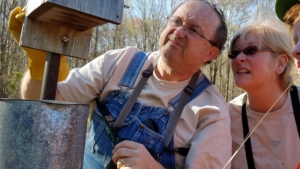
George and Cathy checking a bird box. Photo by Doug Mason.
However, needs change and a good life marches forward opening doors to new adventures. Cathy mentioned to me in an email interview, “My husband and I will be relocating to Barnstable, Massachusetts and will remain connected and involved to a much lesser degree with Fairfax County. I retain my affiliation with the Friends of Huntley Meadows Park where both my husband and I are now Board Members Emeritus. I expect to return to Fairfax County regularly for visits and hope to be able to continue some of our activities in the area. We regularly lead bird and nature walks in our Alexandria, Virginia neighborhood and hope to continue to do this. I also intend to maintain my certification status with Fairfax Master Naturalists and can complete activities here when we are in town.”
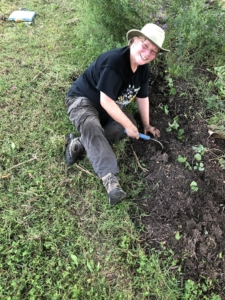
Tilling the soil. Photo George Ledec.
She said, “I hope that my work inspires others to get involved. I have enjoyed living here in Fairfax County for almost 30 years and am sad to leave. On the other hand we are very excited about our new adventure in Massachusetts. We purchased a 4.25 acre waterfront property in the village of Cummaquid and will be working to restore this land to a more natural state. This includes some reforestation and invasive plant removal along with the planting of many native species of trees, shrubs, forbs and grasses. On the property we are lucky to have about 1 acre of salt marsh and a fresh water (Kettle pond) on the property. Already we have a day roost of both Black-crowned and Yellow-crowned Night Herons and nesting Willow Flycatcher and nesting Yellow Warbler. We are nearby the Mass Audubon Society’s Long Pasture Nature Preserve and there is so much to see! Our new home is about 15 minutes away from my 92 year old parents where I am so fortunate to be able to move there to help them out.”
Given all of the above, Cathy remains a humble, altruistic individual who doesn’t mind, in fact, loves to get her hands into the dirt. She said she does not do what she does for the accolades, they seem to come with the territory. She is very appreciative though when the County gives thanks for influencing their decisions towards positive, sustainable environmental impact. So for ‘every bee and every tree” in Fairfax County, FMN joins in thanking Cathy for all she has done and hopefully will continue doing in our shared communities.


